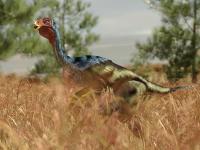Dinosaur Skin Is More Diverse Than Previously Thought

Dinosaur bones are the delight of many museum goers, but everyone, from the youngest dino-fan to the most professional paleontologist, has wondered what these prehistoric beasts might have looked like in the flesh. Unfortunately, most fossils preserve the exact opposite – the hard bony skeleton survives the millennia far easier than soft tissue, which decays away. Scant fossils of Triceratops skin and fossil feathers from meat-eating raptors in China have provided scientists with some rare clues.
In the 1990s, the discovery of a unique theropod, Carnotaurus (or meat-eating bull, so named for the twin horns over it’s eyebrows), caused quite a stir when it’s skeleton bore distinct skin impressions – more than any other single theropod skeleton.
The pebbly skin was occasionally dotted with larger triangular knobs, giving the animal an armored appearance. Unfortunately, much of the skin was destroyed during the painstaking process of fossil preparation.
Now, a new study has reexamined the skin that remains, giving dinosaur enthusiasts their clearest glimpse yet of this horned carnivore.
“By looking at the skin from the shoulders, belly and tail regions, we discovered that the skin of this dinosaur was more diverse than previously thought, consisting of large and randomly distributed conical studs surrounded by a network of small elongated, diamond-shaped or subcircular scales,” explained study co-author Christophe Hendrickx from the Unidad Ejecutora Lillo.
Previous interpretations had suggested the conical scales formed orderly rows along the spine and sides. This new examination illustrates that the feature scales (or “studs”) had a random distribution across the body, growing out of the finer grained and wrinkled basement scales.
What exactly do these skin patterns mean for the biology of Carnotaurus? The function of the “studs” is unclear. The authors dismiss the notion that they may have aided in defense. They instead speculate that the scales may have served a role in display or coloration, though these ideas are hard to test, given that we can’t directly observe such a behavior.
The experts propose that the pebbled basement scales were important in thermoregulation – or controlling body temperature. Similarly, elephants have wrinkly and cracked skin, which helps both to retain water and lose heat through evaporative cooling. Carnotaurus could have used a similar strategy. Since big animals typically have trouble with overheating, such an adaptation might have come in handy during the warm Mesozoic era.
The researchers conclude that future studies should take a more proactive role in describing dinosaur skin, and consider what role this critical organ system might have played in these extinct animals’ lives. Their analysis must be more than skin deep.
The study is published in the journal Cretaceous Research.
Source: https://www.earth.com/








